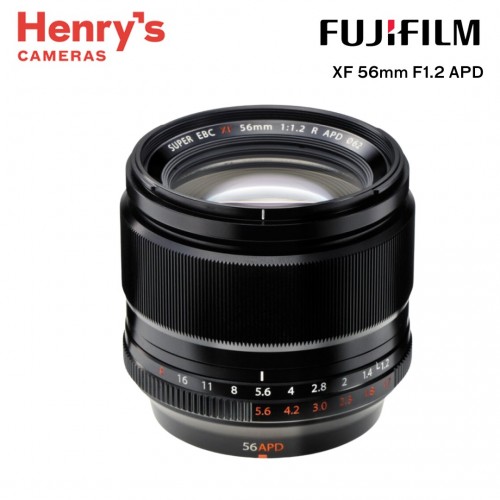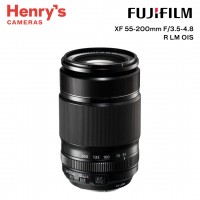Fujifilm XF 56mm F1.2 APD
Fujifilm
-
₱80,085.00
- ₱82,990.00
- -3%
- 0% 3mos BDO, BPI, UNIONBANK, HSBC ₱26,695.00/mo.
CASH PRICE
- 85mm (35mm Equivalent)
- Aperture Range: f/1.2 to f/16
- Apodization Filter for Pleasing Bokeh
- One Aspherical Element
- Two ED Elements
- HT-EBC Multi-Layer Lens Coating
- High Speed AF & Inner Focusing Mechanism
- Seven-Blade Rounded Diaphragm
- Supports X-Series Camera's LMO Function
Lens
| Filter Size | ø62mm |
| Max Magnification | 0.09x |
| Focal Length | f=56mm (85mm) |
| Focus | Normal 0.7m - ∞, Macro 0.7m - 3m |
| Aperture | Min ƒ/16, Max ƒ/1.2 |
| Aperture Control | Number of blades 7 (rounded diaphragm opening), Step size 1/3 EV (23 steps) * 1/2 EV, from max. aperture to next step, only. |
| Angle of View | 28.5° |
| Dimension (diameter x length) | 7.32cm x 6.97cm |
| Lens | XF |
| Mount | Fujifilm X Mount |
General
| Color | Black |
| Warranty | 1 Year Manufacturer |
A large-diameter medium-telephoto prime lens. The fast F1.2 lens produces creamy bokeh, while its 56mm focal length, equivalent to 85mm in 35mm film format, offers a comfortable shooting distance from the subject. X-Series cameras have won a solid reputation for their faithful reproduction of skin tones and combining them with this lens delivers the ultimate portrait photography results. The built-in APD filter, the pinnacle of Fujifilm's nanotechnology, produces even smoother bokeh, making the subject stand out even more and enhances creativity, not only for portraits, but also on a wide range of other subjects.
Apodization filter delivers more creative portraits
The FUJINON LENS XF56mmF1.2 R APD offers brilliant levels
of sharpness even when shooting with the aperture at F1.2. In addition, the
apodization filter smoothes the bokeh's outlines. This combination of image
sharpness and beautiful bokeh delivers portraits with a three-dimensional feel.
An optical construction of 11 glass elements in 8 groups,
including one aspherical glass molded lens element and two extra low dispersion
lens elements has been used. Spherical aberrations are corrected by the
aspherical glass element to deliver high resolution at the maximum aperture
setting. Additionally, thanks to the combination of two extra-low dispersion
lens elements and three cemented lens elements, chromatic aberrations are
greatly reduced.
By applying Fujifilm's unique HT-EBC (High Transmittance
Electron Beam Coating) to all lens surfaces, ghosting and flare are controlled
for sharp, clear results.
The lens also makes the most of Fujifilm's unique
X-Trans™* CMOS
low pass filter-less sensor for extremely high image quality. Ghosting and
flare are controlled even under harsh conditions such as backlighting.
By combining this lens with an X Series camera body** with Lens
Modulation Optimizer*** (LMO) technology, the performance from
the lens is improved even further. LMO corrects for diffraction*4 to produce
images with edge-to-edge sharpness and create a realistic three-dimensional
effect, even at small apertures.
Autofocusing for a lens with an apodization filter
In the past, an apodization filter has only been used on
a manual focus lens, this is the first to use high-precision contrast AF.
Combined with an X Series camera body, more natural shots of subjects are
possible thanks to the near-silent shutter sound.
X Series interchangeable lens cameras are equipped with
Film Simulation modes, which have been developed using Fujifilm's knowledge
from 80 years of manufacturing to deliver film-like colors and tones. Combining
this lens with the Pro Neg. Film Simulation mode, which is specifically
designed for portrait photography, reproduces beautiful skin tones.
The apodization filter delivers its best results at wider
apertures. To enable wide apertures to be used even in bright environments, an
ND filter is included that adjusts brightness in three levels. To indicate the
apodizing effect, the lens features an aperture ring showing the effective F
No. in red. The difference between the F No. and the effective F No. indicates
the effectiveness of the apodization filter.
Both the focus and aperture rings are metal, plus metal is also used on the exterior of the lens body for a high-quality finish. The texture and torque on the rings makes for comfortable shooting even for delicate manual focusing.
Complementing the unique focusing and bokeh-related attributes
of the lens is an equally sophisticated optical design, which features 11
elements in 8 groups and includes one aspherical element, two extra-low
dispersion elements, and three cemented elements. Together, these elements
contribute to a notable reduction in chromatic aberrations, distortions, and
color fringing throughout the aperture range. Additionally, an HT-EBC
multi-layer coating has also been applied to elements to minimize surface
reflections, flare, and ghosting for more contrast-rich, color-neutral results.
Prime short telephoto-length lens provides a
35mm-equivalent focal length of 85mm, making it ideal for portraiture and other
applications where a slightly longer-than-normal perspective and flattening
appearance is desired.
Bright f/1.2 maximum aperture is well-suited to low-light
shooting and for controlling focus placement for shallow depth of field and
selective focus applications.
Signified by the APD designation, this lens incorporates
an apodizing filter in order to produce controllable and aesthetically-pleasing
bokeh, that is characterized by a sharp main subjects, tremendously blurred
background, and an overall three-dimensional quality. These effects are further
emphasized by seven rounded diaphragm blades, which help to develop a circular
quality to out-of-focus highlights.
Since the apodization filter performs best at wider
aperture values, a 3-step ND filter is built into the lens to aid in
controlling exposure. Using two separate sets of aperture values, the red
series of numbers indicates the effective aperture value as it relates to depth
of field. The standard white set of numbers indicates the actual f/stop number,
and the difference between these two sets of numbers indicates the
effectiveness of the filter.
Comprised of 11 elements in 8 groups, the optical design
includes one aspherical glass molded element, two extra-low dispersion
elements, and three cemented elements. This sophisticated layout helps to
minimize chromatic and spherical aberrations as well as color fringing and
other distortions.
An HT-EBC multi-layer coating minimizes lens flare and
ghosting to deliver contrast-rich, color neutral imagery.
An inner focusing mechanism maintains the overall lens
length and moves only the smaller middle and rear elements during focusing for
faster, more reliable performance.
When used with an X-series camera that features a Lens Modulation Optimizer (LMO) function, the lens' performance is enhanced to deliver consistent illumination and sharpness throughout the aperture range.







-90x90.jpg)
-90x90.jpg)
-90x90.jpg)
-90x90.jpg)
-200x200.jpg)
